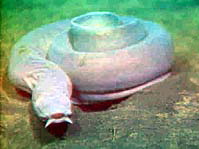Myxini
| Hagfish | |
|---|---|
 |
|
| Pacific hagfish resting on the ocean bottom, at 280 m depth off the Oregon coast | |
| Scientific classification | |
| Kingdom: | Animalia |
| Phylum: | Chordata |
| Subphylum: | Vertebrata |
| Superclass: | Cyclostomata |
| Class: | Myxini |
| Order: | Myxiniformes |
| Family: |
Myxinidae Rafinesque, 1815 |
| Genera | |
|
|
| Synonyms | |
|
Bdellostomatidae |
|
Bdellostomatidae
Hagfish, the class Myxini (also known as Hyperotreti), are eel-shaped, slime-producing marine fish (occasionally called slime eels). They are the only known living animals that have a skull but no vertebral column. Along with lampreys, hagfish are jawless; they are the sister group to vertebrates, and living hagfish remain similar to hagfish from around 300 million years ago.
The classification of hagfish has been controversial. The issue is whether the hagfish is a degenerate type of vertebrate-fish (most closely related to lampreys), or represents a stage that precedes the evolution of the vertebral column (as do lancelets). The original scheme groups hagfish and lampreys together as cyclostomes (or historically, Agnatha), as the oldest surviving class of vertebrates alongside gnathostomes (the now-ubiquitous jawed vertebrates). An alternative scheme proposed that jawed vertebrates are more closely related to lampreys than to hagfish (i.e., that vertebrates include lampreys but exclude hagfish), and introduces the category craniata to group vertebrates near hagfish. Recent DNA evidence has supported the original scheme.
Hagfish average about 0.5 m (19.7 in) in length. The largest known species is Eptatretus goliath with a specimen recorded at 127 cm (4 ft 2 in), while Myxine kuoi and Myxine pequenoi seem to reach no more than 18 cm (7.1 in) (some have been seen as small as 4 cm (1.6 in)).
Hagfish have elongated, eel-like bodies, and paddle-like tails. The skin is naked and covers the body like a loosely fitting sock. They have cartilaginous skulls (although the part surrounding the brain is composed primarily of a fibrous sheath) and tooth-like structures composed of keratin. Colors depend on the species, ranging from pink to blue-grey, and black or white spots may be present. Eyes are simple eyespots, not compound eyes that can resolve images. Hagfish have no true fins and have six or eight barbels around the mouth and a single nostril. Instead of vertically articulating jaws like Gnathostomata (vertebrates with jaws), they have a pair of horizontally moving structures with tooth-like projections for pulling off food. The mouth of the hagfish has two pairs of horny, comb-shaped teeth on a cartilaginous plate that protracts and retracts. These teeth are used to grasp food and draw it toward the pharynx.
...
Wikipedia
